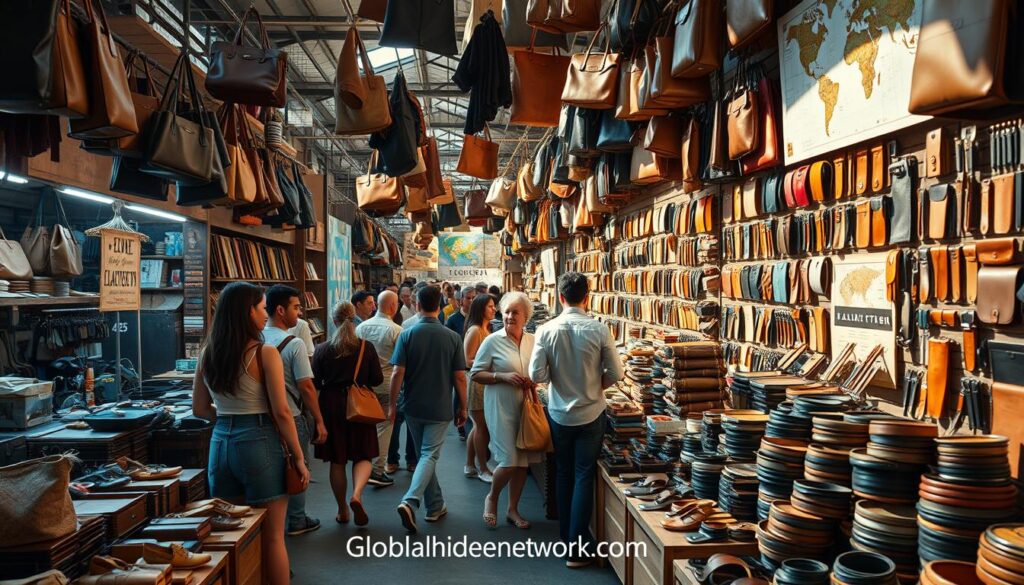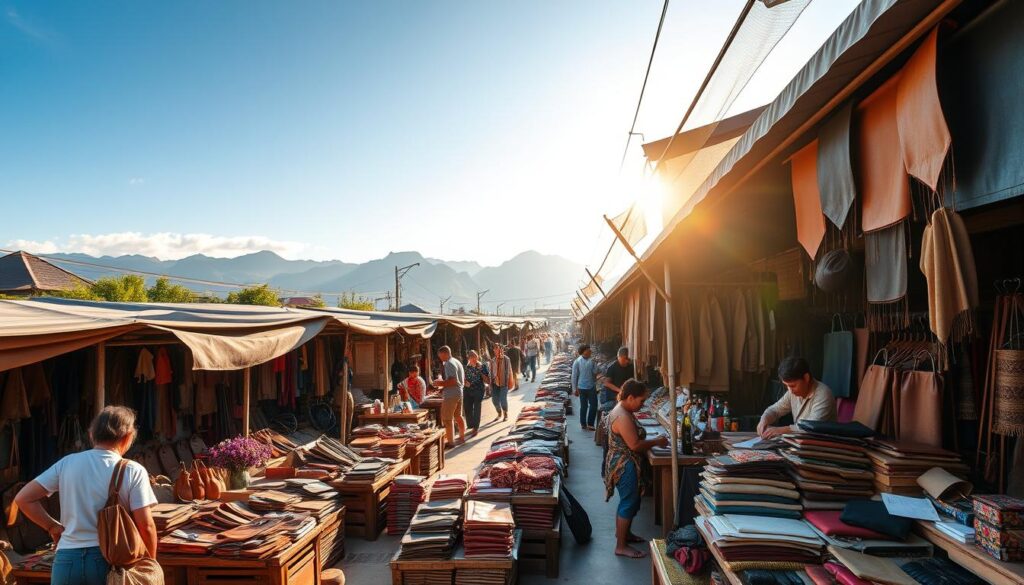I’ve seen a big change in the global leather industry. People are now looking for different things and caring more about the planet. This has made it hard for old leather products to keep up.
But, there’s a silver lining. The leather market is starting to change. It’s moving towards being more green and trying new things. The global leather goods market was worth $242.85 billion in 2022. It’s expected to grow by 6.6% every year from 2023 to 2030.
This growth is because more people have money to spend and fashion is always changing. It’s a great chance for businesses to grow in the leather market.
Key Takeaways
- Global leather goods market valued at $242.85 billion in 2022
- Expected CAGR of 6.6% from 2023 to 2030
- Genuine leather segment held 53.6% market share in 2022
- Footwear segment dominated with 39.3% market share
- Asia Pacific led with 36% revenue share in 2022
- Market projected to reach $405.28 billion by 2030
- Key players include Adidas AG, Nike, Inc., and Puma SE
Introduction to the Global Leather Industry
I’ve always been interested in the global leather industry. It has a long history and is now a huge market. Leather is used in fashion, cars, and more all over the world.
Historical Context of Leather Trading
Leather trading has been around for thousands of years. Ancient people used it for clothes, homes, and tools. Tanneries then learned how to make leather strong and useful.
Current Market Size and Valuation
The leather industry has grown a lot. In 2021, it was worth $29,934.61 million. It’s expected to reach $44,839.65 million by 2027, growing 6.97% each year. This growth comes from shoes, furniture, and cars.
Key Players in the Global Leather Market
Big names lead the industry. Companies like Twin City Hide and San Fang Chemical are leaders. Luxury brands like Louis Vuitton also play a big role. Countries like China, India, Brazil, and Italy are big producers and exporters.
| Region | Key Contribution | Market Share |
|---|---|---|
| China | Largest exporter, 67% of world’s shoes | 36% of leather goods exports |
| Europe | Premium brands, sustainable practices | Leading market position |
| USA | Major producer and consumer | Focus on innovation |
Market Dynamics and Growth Factors

The global leather market is growing fast. It’s expected to reach $376.21 billion by 2029, up from $304.80 billion in 2024. This growth is thanks to new trends and more people wanting leather goods.
Europe is the biggest market now, but Asia-Pacific is growing the fastest. More money to spend and new fashion trends are helping this growth. People want trendy leather items, making makers work harder to be creative.
Big names like Kering SA and Hermès International S.A. are changing with the times. They’re making their products better and using smart marketing. Celebrities are also helping to make leather goods more popular.
The shoe market was worth $135.50 billion in 2018. It’s still the biggest part of the market. Makers are now making shoes that fit what people want. Online shopping is also growing, showing how shopping habits are changing.
But, the industry has its challenges. People are worried about the environment and animal rights. This is making makers look into new, green options. This could change how we see leather goods in the future.
The Global Leather Trading Market: Key Segments
I’ve been looking into the leather industry. It’s amazing to see how it’s split into different parts. The global leather goods market was worth $255.45 billion in 2023. It’s expected to grow a lot in the future.
Footwear Segment Dominance
Leather shoes are at the top of the market. In 2022, they were the biggest, with athletic shoes becoming more popular. Even when U.S. shoe sales dropped by 32% in the first half of 2020 because of COVID-19, the market stayed strong.
Accessories and Luxury Goods
Luxury leather items are doing well, especially in Asia Pacific. China’s growing rich population is boosting demand. Europe is also seeing an increase in leather accessories like belts and handbags.
Automotive Leather Applications
The car upholstery market is set to grow fast. Luxury car makers are using more leather interiors. This is making the segment bigger.
| Segment | Market Share (2022) | Growth Projection |
|---|---|---|
| Leather Footwear | 39.3% | Steady growth |
| Luxury Leather Goods | 28.7% | Rising demand in Asia |
| Automotive Upholstery | 18.5% | 7.3% CAGR (2023-2030) |
| Other Leather Products | 13.5% | Varied growth rates |
Big names like Adidas, Nike, and Prada are investing in leather goods. This makes the future look bright for all leather segments.
Regional Analysis: Asia Pacific’s Market Leadership

I’ve seen a big change in the leather trade world. The Asia Pacific leather market is now a big leader, with 36% of the revenue in 2022. This area is changing how leather is traded all over the world.
China and India are leading this growth. They are driving the demand for high-quality and luxury leather goods. Their growing middle classes and more money to spend are helping this trend. Bangladesh and Pakistan are also key, providing primary leather for making goods.
The Asia Pacific leather goods market is growing fast. It’s expected to hit $164,326.57 million by 2030, with a 7.30% CAGR. This growth is faster than many other areas, making Asia Pacific a top market.
| Region | Market Share (2022) | Projected CAGR | Key Drivers |
|---|---|---|---|
| Asia Pacific | 36% | 7.30% | Premium product demand, rising disposable income |
| Europe | – | 6.7% | Strong demand for leather accessories |
| North America | – | – | Luxury goods market, sustainable leather trends |
Asia Pacific is leading, but other areas are growing too. Europe is expected to grow at 6.7% CAGR, thanks to leather accessory demand. The leather trade is expanding globally, offering new chances for businesses and investors.
Emerging Trends in Leather Manufacturing
I’ve seen big changes in the leather world. Now, we’re making more sustainable leather and finding eco-friendly options. It’s cool to see how new tech is helping us make better products.
Sustainable Leather Production Practices
The leather industry is going green. Tanneries are using natural methods instead of harsh chemicals. This makes the leather better for the planet and looks great too.
Technological Advancements in Tanning
Leather tech has improved a lot. Now, we can make cool designs with laser cutting and digital printing. It’s amazing to see what’s possible with leather today.
Innovative Leather Alternatives
New eco-friendly materials are changing the game. We’re making leather from mushrooms and recycling old fabrics. This is good for the planet and makes people happy.
| Material | Environmental Impact | Market Growth (CAGR) |
|---|---|---|
| Traditional Leather | High | 6.7% |
| Synthetic Leather | Medium | 9.5% |
| Vegan Leather | Low | 10% |
The leather world is changing fast. We’re making more sustainable leather and finding new, green options. It’s all about finding a balance between old ways and new tech.
Consumer Behavior and Preferences
I’ve seen a big change in what people want from leather goods. Now, knowing the brand is key. People like Adidas AG, Nike, Inc., and Puma SE. The market is growing fast, expected to hit $764.81 billion by 2033.
What people want is comfort, style, and to be green. More folks want leather that’s good for the planet. This is why synthetic leather is growing fast, at a 7.5% CAGR.
Footwear is the biggest part of the market, making up 44% of sales. People also want leather goods that are just for them. Adidas is making products like mushroom leather trainers to meet this need.
| Region | Market Share | Market Size (2023) |
|---|---|---|
| North America | 37.65% | $121.95 billion |
| Asia-Pacific | 38% | $154.47 billion |
| Europe | 24.35% | $98.46 billion |
As people’s lives change, so does the leather goods market. Brands are making new, exciting products. The future of leather goods is bright, with a focus on being green and new.
E-commerce Revolution in Leather Goods Distribution
I’ve seen a big change in how leather goods are sold. Online leather retail is taking off in a big way. In 2023, online stores had the biggest share of the market. This shift is changing how leather brands reach customers.
Growth of Online Leather Goods Sales
The numbers tell a clear story. The global leather market is set to grow from $319.01 billion in 2021 to $508.47 billion by 2026. That’s a huge jump! A big reason for this growth is online shopping. People love buying leather goods online because it’s easy and they can find more choices.
Digital Marketing Strategies for Leather Brands
Leather brands are getting creative with digital marketing. They’re using social media to show off their products and connect with customers. Some brands are even working with influencers to reach more people. These strategies help brands stand out in a crowded online market.
Omnichannel Retailing in the Leather Industry
Leather companies are now using an omnichannel strategy. This means they sell both online and in stores. Customers can shop on a website, then pick up their items in a store. Or they can try on shoes in a store and order them online later. This mix of online and offline shopping gives customers the best of both worlds.
| Year | Market Size (Billion USD) | Growth Rate |
|---|---|---|
| 2021 | 319.01 | – |
| 2026 | 508.47 | 9.8% |
| 2031 | 781.98 | 9.0% |
This e-commerce revolution is changing the leather industry. Brands that adapt to online selling and use smart digital marketing are seeing big rewards. The future of leather goods looks bright, with more growth expected in the coming years.
Challenges Facing the Global Leather Trade
I’ve been looking into the leather industry challenges. It’s clear this sector faces tough hurdles. The global leather goods market was worth $394.12 billion in 2020.
One big problem is the environmental impact of leather production. Leather has a sustainability rating of 159, compared to 44 for polyester. The industry must find greener solutions quickly.
Supply chain disruptions have hit the leather trade hard. In 2020, U.S. exports of leather products dropped by $276 million. The COVID-19 pandemic caused delays in shipments and deliveries.
These disruptions affect everything from raw material sourcing to final product distribution. Competition from synthetic alternatives is another major challenge. Synthetic leather makes up about two-thirds of the market volume and one-third of its value.
The synthetic leather market is worth around $28 billion. Traditional leather producers are feeling the squeeze. With growing demand for sustainable products, the leather industry must adapt quickly to survive and thrive.
